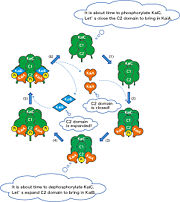Circadian Clock Protein KaiC
From Proteopedia
Contents |
Introduction
Biological Circadian Clocks are self-sustaining oscillators that function on a rhythmic cycle of or around 24 hours. They are found in almost all organisms, the simplest of which are cyanobacteria, which have been extensively studied in order to determine the mechanism of the fine-tuned biological process of circadian rhythmicity. In most eukaryotes, a region of the brain called the superchiasmic nuclei detects light and dark cycles, then relays the message to biological clock systems that maintain rhythmicity within the body. Conversely, cyanobacteria have a fairly modest system comprised of three proteins: KaiC, KaiA, and KaiB. The system is based around the central protein KaiC which exhibits ATP binding, inter-subunit organization, a scaffold region for Kai protein complex formation, a location where critical mutations are found, and an evolutionary link to other well-known proteins [1]. In order to devise an explanation for the mechanism of biological oscillators, we need to characterize the structure, function, and interactions among molecular components. To study these, most scientists start with analyzing cyanobacteria, since it is the smallest organism that expresses circadian clock properties.
KaiC - KaiA - KaiB System
The system by which the protein complex maintains a precise tme constabnt and temperature compensation is acheived by the cooperation of a three-protein network. In a nutshell, KaiC requires ATP to autophosphorylate while KaiA enhances this phosphorylation and KaiB antagonizes it. KaiC is the central clock protein, which has autokinase and autophosphorylase activity. Yet in the presence of ATP alone, KaiC cannot perform it's autophosphorylation function. It requires two other proteins, KaiA and KaiB, the genes of which are found in the same cluster on the chromosome [1]. Although KaiC phosphorylates itself, the presence of KaiA and KaiB are essential to rhythmicity. KaiA stimulates KaiC autophosphorylation, possibly by stabilizing the phosphorylated form of KaiC. On the other hand, KaiB antagonizes the process possibly by enhancing KaiC dephosphorylation or interfering with the binding of KaiA to KaiC. Even in the presence of high ATP, KaiB still prompts KaiC to dephosphorylate [2]. The mechanism is not well understood and is the focus of further study.
KaiC Homohexameric Complex
| |||||||||||
Biological Importance
- Nearly all promoters in a cyanobacteria are under circadian control. [function is important to whole life cycle] (1) - Structure similarity with RecA and DnaB. RecA is a DNA recombinase and DnaB is a DNA helicase, so the observation that there is similarity between these molecules imply possible direct interactions with DNA.
References
Proteopedia Page Contributors and Editors (what is this?)
Ashley Beechan, Michal Harel, Alexander Berchansky, Jaime Prilusky

